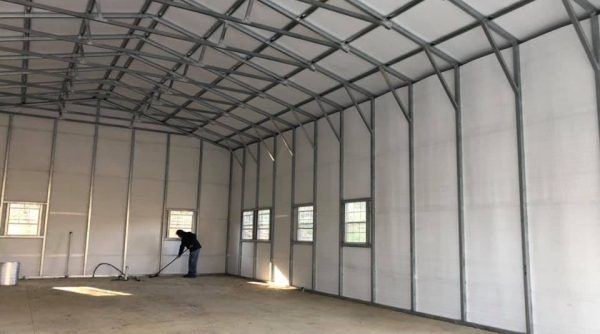Metal garages are popular today, with their sleek and modern look, but they do require some extra attention when it comes to insulating them. Here’s a guide that takes you from the start of the project to the end.
Insulation is key to keeping your home warm in the winter and cool in the summer. There are a few different types of insulation, but the most common is foam insulation. Foam insulation is made up of small bubbles of air. The bubbles help to keep heat trapped within the insulation, which helps to keep your home cooler in the summer and warmer in the winter.
How can I insulate a metal garage?

One of the most important steps in insulating a metal garage is to choose the right type of insulation. There are three main types of insulation for garages: fiberglass, cellulose, and mineral wool.
Fiberglass is the cheapest option and is made from long strands of glass fiber. It’s good for tight spaces because it doesn’t create thermal bridges between the insulation and the cold surfaces it covers. However, fiberglass is not very durable and can easily be damaged by moisture or sunlight.
Cellulose insulation is made from wood pulp and paper fibers. It’s more expensive than fiberglass but it’s also more durable and has a longer lifespan. Cellulose insulation creates a lot of thermal barriers so it can be used in larger spaces without risking damage to the walls.
Mineral wool is the most expensive option but it also offers the best performance. Mineral wool is made from tiny balls of polypropylene that have been compressed into a thick layer. It’s resistant to moisture and heat so it’s good for areas that get a lot of exposure to sunlight or rain.
Myths of Metal Garage Insulation
There are many myths about metal garage insulation, and it’s important to be aware of them before you make any decisions about whether or not to insulate your garage. Here are six of the most common myths:
1. Insulating a metal garage will create a lot of heat.
This is not true! In fact, if you insulate a metal garage, you’ll likely end up saving on energy costs. The reason is that metal is an excellent thermal conductor, which means it easily transfers heat from one area to another. Insulating your garage will also reduce noise and vibration, two other factors that can contribute to energy costs.
2. It’s too cold outside to insulate my garage.
This isn’t always the case! If the temperature outside is below freezing, then insulation may not be necessary since the cold air already has a high thermal conductivity. In addition, if your home experiences extreme cold weather conditions (below 0 degrees Fahrenheit), then insulation may be essential in order to keep your family warm.
3. It’ll take a long time to insulate my garage.
This isn’t necessarily true! In fact, depending on the type of insulation you choose and how much work you’re willing to do yourself, it should take anywhere from a few days to several weeks to complete the job. As long as you have all the materials you need on hand and are prepared for some minor repairs along the way, ins ulating your garage should be a relatively easy project.
4. I can’t insulate my garage because the roof is too sloped.
This isn’t always the case! If you have a metal roof, you can usually insulate it without any problems. In addition, if you live in an area where there is significant snowfall, insulating your garage may be your best option in order to prevent the accumulation of snow and ice on the roof.
5. The insulation willBlock the sunlight.
This is also not true! In fact, most types of insulation are designed to allow sunlight to enter through the windows and create a warm and inviting space inside your garage. Additionally, some types of insulation actually improve air circulation and help prevent moisture buildup, both of which are beneficial for safety reasons.
A Warning
If you’re like most homeowners, your garage is probably one of the warmest and most comfortable spaces in your home. Unfortunately, metal garages are very inefficient in terms of energy usage, so they can quickly become expensive to operate. In this guide, we’ll show you how to insulate a metal garage to make it more energy-efficient, and help reduce your monthly utility bills by up to 50%.
Before insulation:
It’s important to start by assessing your current garage insulation levels. If your garage is currently insulated with fiberglass batts or blown cellulose insulation, you may not need additional insulation. However, if your garage is uninsulated or only partially insulated, adding proper thermal protection will improve the performance of the existing insulation and save you money on your monthly utility bills.
Types of thermal protection:
There are a few different types of thermal protection that can be used to improve the performance of an uninsulated metal garage: spray foam insulation, rigid foam insulation panels, horizontal battens (also known as “rabbit ears”), and Insul-TEC® panels. Each type of thermal protection has its own benefits and drawbacks, so it’s important to choose the right type for your specific needs.




